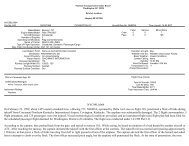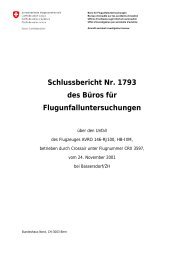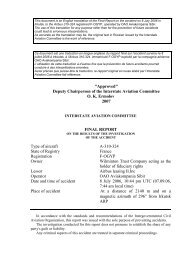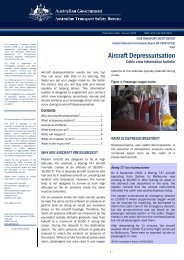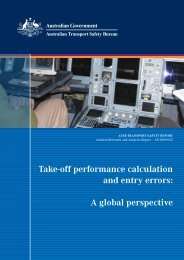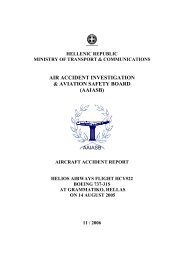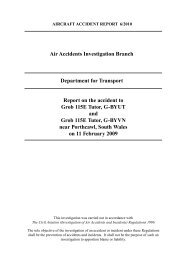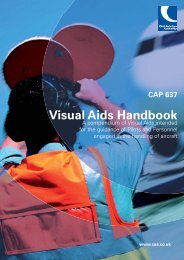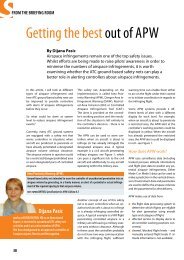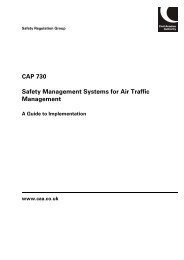CAP 772 - Birdstrike Risk Management for Aerodromes - SKYbrary
CAP 772 - Birdstrike Risk Management for Aerodromes - SKYbrary
CAP 772 - Birdstrike Risk Management for Aerodromes - SKYbrary
Create successful ePaper yourself
Turn your PDF publications into a flip-book with our unique Google optimized e-Paper software.
<strong>CAP</strong> <strong>772</strong> <strong>Birdstrike</strong> <strong>Risk</strong> <strong>Management</strong> <strong>for</strong> <strong>Aerodromes</strong><br />
effect than other devices. Bird scaring relies on persuading birds of the presence of<br />
such danger.<br />
3.2.2 One of the key elements of effective scaring is to avoid habituation. Any scaring<br />
system used needs to be effective over large areas and not ignored by the birds after<br />
a limited period. Accordingly, the scaring stimulus should be taken to the target birds<br />
and used only when it is required.<br />
3.2.3 Several types of bird scaring devices and techniques exist, some of which are<br />
examined in the following paragraphs. Birds react strongly to signals from other birds<br />
that indicate danger, distress (when captured by a predator) or death, and habituation<br />
does not readily occur. Some birds, typically social species that communicate with<br />
each other vocally (such as Gulls, Lapwings, Corvids and Starlings) emit piercing<br />
repeated distress calls when captured by a predator. Young birds emit distress calls<br />
more readily than adults.<br />
3.2.4 The use of recorded distress calls (bio-acoustics) is considered the most efficient and<br />
cost effective method <strong>for</strong> dispersing birds from aerodromes. However, although a<br />
distress call is a warning of potential danger, it is not a scaring device in the<br />
conventional sense in that the bird's response is not to depart immediately and<br />
quickly. In addition, this method is species-specific and may cause the birds to react<br />
defensively rather than disperse. For instance, on hearing a distress call birds may<br />
become alert and take flight; approach the sound source and circle overhead or<br />
nearby, often emitting alarm calls; dive threateningly at a predator; or just disperse to<br />
a less risky location. This inconsistent and unpredictable behaviour pattern<br />
demonstrates that a distress call should only be used when no aircraft are operating<br />
locally. It may take 10 minutes or more <strong>for</strong> birds to depart the aerodrome and there is<br />
no control over direction of dispersal; there<strong>for</strong>e, distress calls should only be used to<br />
deter birds when there is ample time between aircraft movements, or at the start of<br />
the day.<br />
3.2.5 Alarm calls are produced by some species when they sight a predator. The function<br />
of alarm calls is to alert other birds to potential danger but, beyond that, any further<br />
reaction may depend on the actions of the predator. Thus, alarm calls are not normally<br />
used to disperse birds from aerodromes.<br />
3.2.6 It is almost always impractical to use dispersal measures to exclude Waterfowl from<br />
water. They feel secure on the water and, if threatened, tend to remain there.<br />
3.2.7 When any bird scaring technique or dispersal method is used, the behaviour of the<br />
birds in relation to aircraft movements has to be taken into consideration and care<br />
must be taken not to increase the risk of a birdstrike as a consequence.<br />
3.2.8 Dispersal by Distress Signals<br />
3.2.8.1 Birds respond best to distress calls of their own species. They also react well to those<br />
of closely related species, but may ignore others. It is there<strong>for</strong>e important to identify<br />
the target birds be<strong>for</strong>e attempting to disperse them. With mixed flocks, it may be<br />
necessary to broadcast several species' calls in sequence to disperse all the birds.<br />
3.2.8.2 Gulls and Corvids typically react very well to recorded distress calls, Lapwings react<br />
fairly well (probably because of their ability to defend nests and young with aggressive<br />
flight manoeuvres), but Starlings have the weakest reactions and are difficult to<br />
disperse by this method.<br />
3.2.8.3 Flocks react similarly to recorded distress calls played back in the field by taking flight<br />
and approaching the source of the call to investigate. However, in this instance, only<br />
the audible stimulus is presented; there<strong>for</strong>e, if the broadcast is continued the birds<br />
will probably continue to fly to and fro <strong>for</strong> many minutes. When the broadcast is<br />
March 2007<br />
Chapter 4 Page 7





